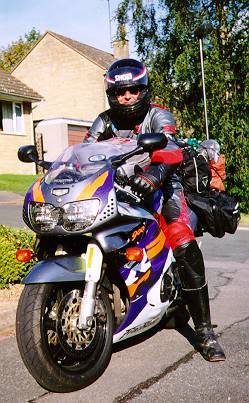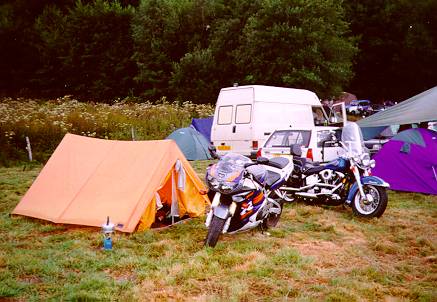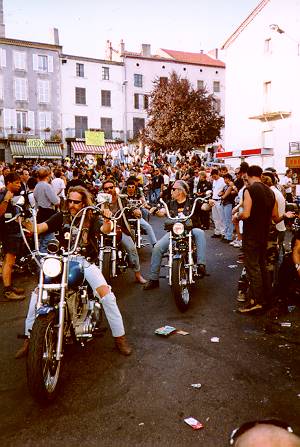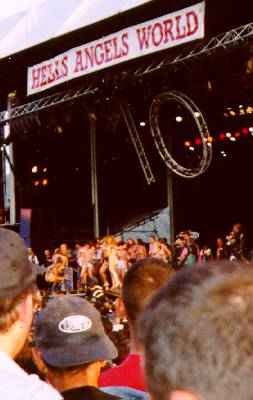Honda CBR900RR Fireblade
More of my thoughts about riding a Blade in Zen in the Art of
Motorcycling
 I would not have thought about buying a Blade if Peter Toft had not kept
going on about them. At the time I had my XV750 SE and a decade of
motorcycle development had passed me by. I was happy. I had a bike. I had a family, I
wasn't doing any great mileage in a year, and it was not obvious to me that I needed
another bike.
I would not have thought about buying a Blade if Peter Toft had not kept
going on about them. At the time I had my XV750 SE and a decade of
motorcycle development had passed me by. I was happy. I had a bike. I had a family, I
wasn't doing any great mileage in a year, and it was not obvious to me that I needed
another bike.
The trouble was that Peter kept on about Blades. He didn't have one. He didn't have any
firm plans for buying one. He just kept mentioning a Blade every time the subject of bikes
came up. It began to prey on my mind.
I started to buy magazines. I decided I ought to take a look at one. Then I sat on one.
Then I spent five months trying to talk myself out of the idea. I spent from May until
September of 1996 arguing with myself. The argument went something like this
Pro: "You've spent 28 years riding motorbikes and you have never
had a first-rate bike. You might die tomorrow."
Con: "You'll use it three times a year, and when depreciation is
included, the cost of each trip will add up to a foreign holiday."
And of course, while the argument that I might die tomorrow was persuasive, there was
the counter-argument that a Fireblade might well be the cause.
I gave in when the season was almost over, and bought a mint condition second-hand
Blade from Fowlers with 1700 miles on the clock. In the following twelve months I rode
7000 miles. I was, and am, utterly obsessed by the bike. This obsession is laid bare in a letter I wrote to the editor of the Sunday Times, and copied to Jeremy
Clarkson.
There are two kinds of people who write about Fireblades. There are those who say it is
brilliant, and imply it is flawless, and those who point out its problems. I have three
gripes. The first is the fact that I spend much of my time riding at 4000-6000 revs, right
in the middle of the flat spot. In top gear, 6000 revs is 100 mph, so you can see that
passing a line of traffic when I'm in top gear at 42 mph isn't stressing the engine. It
isn't that the bike needs the revs; it is the fact that overtaking at 7000 rpm when the
power arrives in a big way is such a headfuck it becomes addictive. It is supernatural. It
is like that bit in Star Treck when the Enterprise goes into warp. Time
compresses and dilates simultaneously. Something strange takes place in the brain at high
speed - so much is happening, it feels like time is slowing down, the reverse of the
feeling that time speeds up as you get older. At the same time the horizon comes closer at
a horrifying speed.
One day I was behind a Porsche Carrera at a junction on a little country road. The
driver floored the accelerator. Because it was a busy junction I started from 50 yards
behind. Normally I just pass cars as if they weren't there. The Porsche was accelerating
hard. A car was coming towards me. The road was running out. That flat-out moment,
shifting gears at 10,000 rpm as I passed the Porsche before I hit the car coming the other
way, lasted a long, long time. I lost the Porsche, went around a couple of bends, then
slowed down and glanced down at the speedo. I was doing 120 mph. My sense of time and
speed is so warped on a Blade it is difficult to judge either.
But I digress. The second gripe is the handling. Despite its reputation, I agree with
those who find the front twitchy and unsettling. Part of this is the 16 inch front wheel.
I haven't meddled too much with the suspension, but I am not completely comfortable with
the way the bike feels in a corner. The original tyres were Michelin Hi-Sport, and are now
Bridgestone BT56s. Perhaps there isn't a problem - I need to learn to relax more in
corners. On the other hand, those who know reckon a smaller rear tyre than the standard
fitting makes a big difference.
The bike makes a splendid tourer. I rode 2000 miles around France in a week, most of
that in four days, as I was stationary for three days. I was self-sufficient - tent,
stove, food, sleeping bag, the works. I have never been so completely at ease with a bike.
My longest day's run was from Dijon to Wotton-Under-Edge in Gloucestershire, about 600
miles, much of the time on minor roads, and I wasn't uncomfortable. And that brings me to
my last gripe. A bike that tours so well ought to have a better selection of tyres. I
practically wore out a set of BT56s in a week. The tyres cost more than all my other
travel expenses combined.
| The moment of my return from France
preserved. What follows is some geeky stuff on luggage. This is an important issue when
touring on a bike. Think of it as hiking at 120 mph. Should one pack the complete history
of the Blues on CD? Or should one settle for Misner, Thorne and Wheeler's Gravitation,
and risk thinking about differential forms and outer products while driving around French
roundabouts in the opposite sense to the locals (when one adopts the postmodern outlook
one cannot say "the wrong way"). It is a difficult choice.
The tank bag is by Baglux, and it clips onto the matching tank cover. Buy one. The rear
luggage is a three piece set by Frank Thomas that clips to the bungee fixing points on the
Blade and was stable at 120 mph. Most of the bulk is on the pillion seat - the side
paniers contained a loose assortment of food, cooking stuff, and Terry Pratchett. Novels
that is - Terry couldn't make it.
Jan made a fitted "horse blanket" out of a heavy wool material to cover the
rear of the bike. This eliminated chafed paintwork. You can just see the blue material
sticking out at the front of the luggage.
The Blade has a useful space under the pillion seat. In it I carried the official tool
kit, my unofficial tool kit, an Abus chain, a puncture repair aerosol, and an alarm I
fitted the day before leaving. The Oxford Roc U-shackle is in a holder behind the number
plate. Lightweight sports bike? You have to be kidding.
Note the elastic cargo net over everything. Into this I shoved sandwiches, soft drinks,
drying underwear, a J-cloth, and a bottle of water for cleaning my visor. Underwear dries
quickly at 100 mph in the French sun. |
 
|
| At Karnak in Britanny, the largest
megalithic site in Europe. The stones are a couple of miles from this campsite. Look at
the bike - it is a lot more interesting than the stones. I drove an enormous distance
and overtook 10,000 camping vans to reach this spot, and it has all the ambience one would
expect if Stonehenge was relocated to the outskirts of Torquay. The place is basically a
seaside town. The stones are fenced off, and there are few footpaths. An assortment of
Eurotouristes take it in turns to drive over your feet with their camping vans and blow
fragrant puffs Chanel's Diesel No. 5 in your face. Vive La France. |
 |
| Cunlhat in the Massive
Central, venue for Freewheels, a motorcycle
festival of massive proportions. From the size of the campsite I would estimate 50,000
people were staying there. It is a European Daytona. I arrived on Friday afternoon, and
left on Sunday morning after two sleepless nights of mayhem.
I found out about it at the Bulldog Bash, a "run-what-ya-brung" bike event at
the Avon Raceway organised by Hells Angels. Cunlhat is organised by Hells Angels Europe,
and happens on the weekend of the Ascension of the Virgin Mary, a national holiday. |
 |
Friday night in Cunlhat. The objective is
to make as much noise as possible. Large bonus points are scored for:
- the number of women on your bike
- their lack of clothing
- S & M couture
- the number of times you have driven through the huge crowd in the main square
Cunlhat is the best possible argument for the thesis that men never grow up. Cunlhat is
the best possible argument for the thesis that men shouldn't grow up.
Cunlhat is a one-horse village. One horse and 50,000 Harley Davidsons. Each year, at
the end of the motorcycle festival, the villagers burn the mayor for agreeing to host the
event. This ancient ritual guarantees the fertility of the land.
If I can extrapolate from the number of people I saw climbing into the adjacent field
to avoid queuing for the toilets, fertility is not likely to be a problem. |
 |
| This began as a wet T-shirt competition.
Each time a winner was declared, another girl would take of some clothes to upstage the
winner. The result of this beggar-my-neighbour contest can be dimly glimpsed, as through a
lens, darkly. These ladies are, in the terminology of the neopagan community,
"skyclad". Clad in more sky than I've seen for a while. Perhaps this was a
subtle, situationist reference to the Ascension of the Virgin, celebrated all over France
that weekend.
"And Monique is wearing a deeply blue Aegean sky, trimmed with a light herringbone
of cirrus, and laced through with golden beams of Mediterranean sunlight."
After leaping about the stage in the nuddy, this crowd of wild maenads marched into
Cunlhat to demand the burning the mayor (see above). (A maenad was the ancient Greek term
for a pack of women who went around tearing men to pieces. Today's equivalent is Women's
Hour on Radio One). |
 |
Back to Home Page
Copyright © Colin Low 1997
 I would not have thought about buying a Blade if Peter Toft had not kept
going on about them. At the time I had my XV750 SE and a decade of
motorcycle development had passed me by. I was happy. I had a bike. I had a family, I
wasn't doing any great mileage in a year, and it was not obvious to me that I needed
another bike.
I would not have thought about buying a Blade if Peter Toft had not kept
going on about them. At the time I had my XV750 SE and a decade of
motorcycle development had passed me by. I was happy. I had a bike. I had a family, I
wasn't doing any great mileage in a year, and it was not obvious to me that I needed
another bike.




